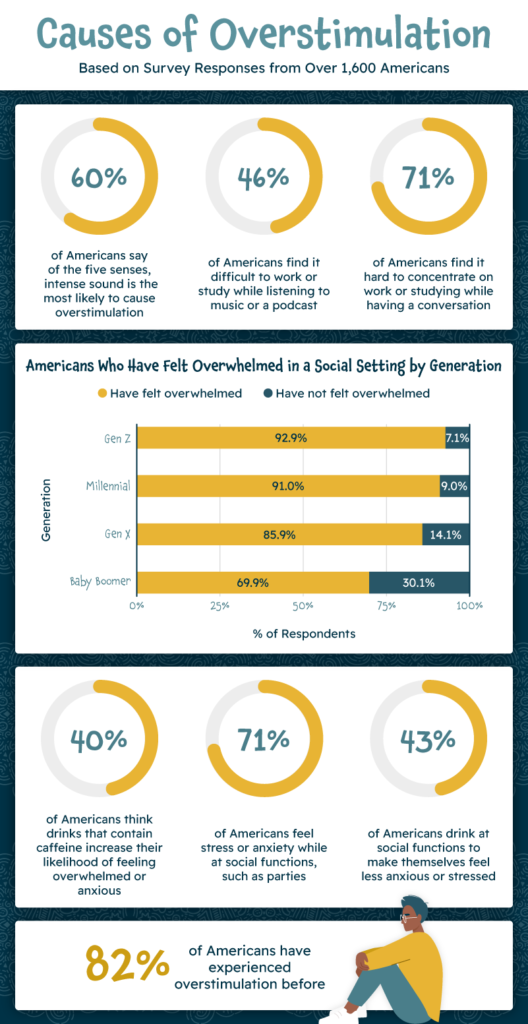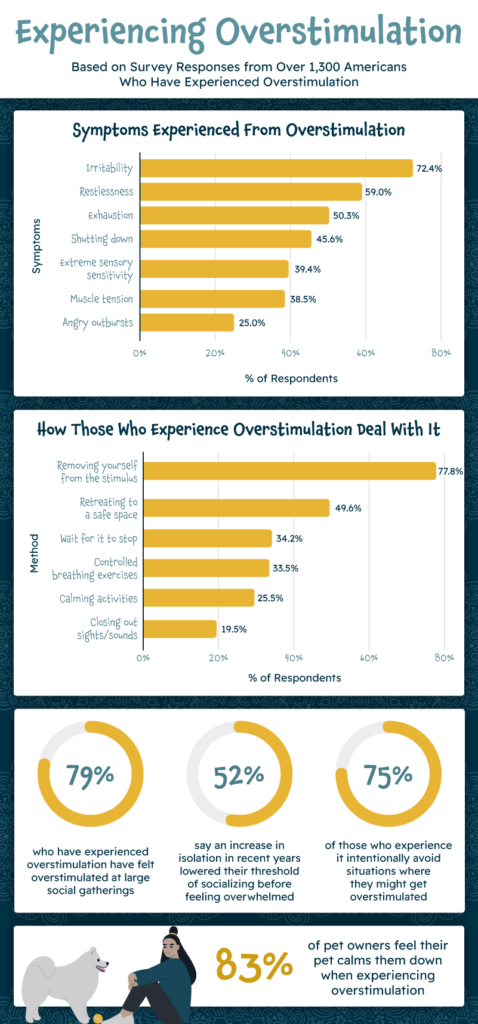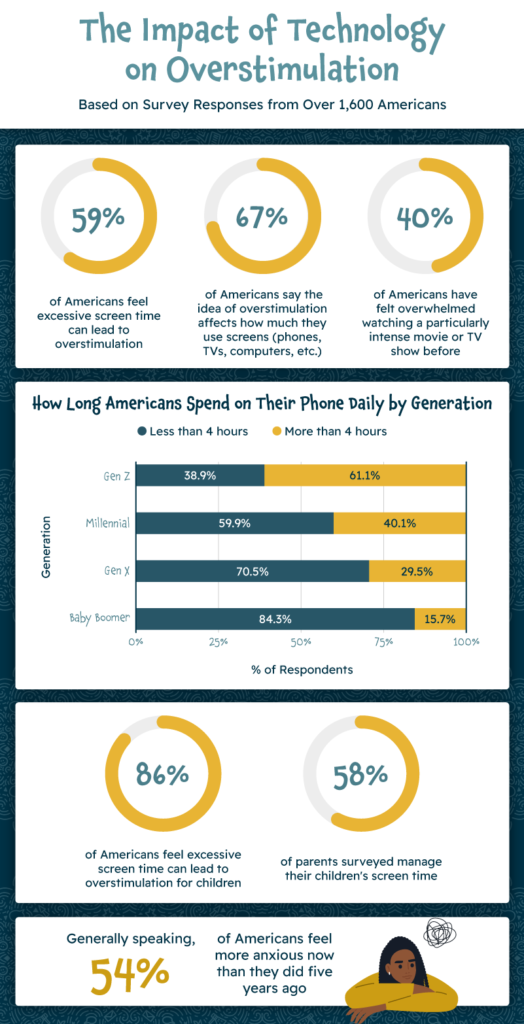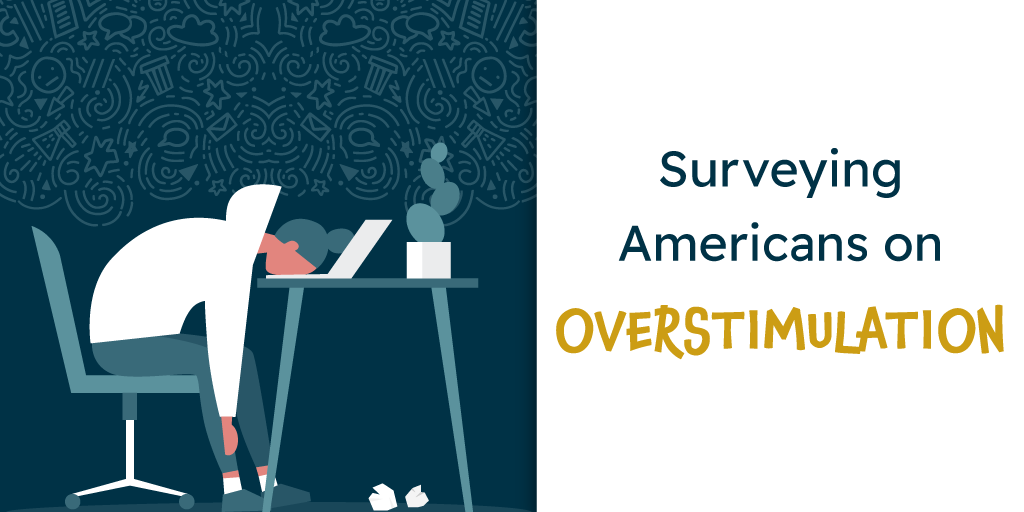Surveying Americans on Overstimulation
From increasing screen times to constant availability to isolation due to COVID-19, sources of overstimulation are abundant and seem to be multiplying. In this campaign, we surveyed Americans to get their thoughts on sensory overload and gain insights into what causes overstimulation for those who experience it, how people who experience overstimulation deal with it, and what role technology has played in widening the scope of or intensifying existing overstimulation.
Methodology
We surveyed a representative sample of over 1,600 Americans over a week in February 2022 to get their thoughts on overstimulation. We got insights about how many people experience overstimulation, what are the most common causes of it, how do these people typically deal with overstimulation, and what causes overstimulation in the digital age. Note that the survey data in the “Experiencing Overstimulation” portion of this piece was only pulled from respondents who said they have experienced overstimulation before (1,339 total people).
Americans’ Thoughts on Overstimulation

Of the five major senses, one’s hearing is the most common victim of overstimulation. In fact, 60% of our respondents say that intense sound is the force that’s most likely to trigger feelings of overstimulation. This probably explains why 71% of Americans feel stress or anxiety at social functions like parties (think about the music, dancing, loud talking, etc.). Overall, however, more than four in every five Americans (82%) have experienced overstimulation at least once before.
In perhaps the first link between technology and overstimulation in our survey, each generation has a higher average number of members that have experienced overstimulation in a social setting than the last. By the end of this upward trend, you can really see the percentage difference between the oldest generation we looked at (baby boomers, 30%) and the youngest (Gen Z, 7%).
Experiencing Overstimulation

So what does overstimulation entail? How can you tell if you’re experiencing overstimulation? Well, according to our respondents, some of the commonly reported symptoms of overstimulation are irritability, restlessness, exhaustion, shutting down, and muscle tension. Luckily there are ways to deal with these though, even if you can’t get away from whatever it is that’s causing the overstimulation.
For example, learning how to perform and then performing controlled breathing exercises can help settle feelings and symptoms of overstimulation in a pinch. If you’re at home and have access to your pet, 83% of our respondents also say that their pet helps them calm down when they’re feeling overstimulated.
We mentioned earlier that 71% of Americans say they get stressed or anxious at social functions like parties, and often overstimulation can be the cause or product of both stress and anxiety, so it makes sense that, according to our survey results, 79% of Americans have experienced overstimulation at a large social function at least once.
Now, these results were pulled in 2022 therefore the respondents have experienced the COVID-19 pandemic, so getting anxious at social functions could be a more prevalent problem now than it might have been in, say, 2019. To further illustrate that point, 52% of our respondents say that long periods of isolation forced onto us by the pandemic have decreased the amount they can socialize before feeling overwhelmed. Whether brought on by the pandemic or otherwise, overstimulation seems to be on the rise.
The Impact of Technology on Overstimulation

Many Americans feel that overstimulation is on the rise. For example, just under three out of every five Americans believe that excessive screen time can lead to overstimulation, 67% of Americans say that overstimulation affects how much they use screens, and a whopping 86% of Americans think excessive screen time can lead to overstimulation for children, and at the same time screen use is increasing drastically with each passing generation.
While these survey results don’t conclusively prove that technology is the number one culprit in the rise of overstimulation, the evidence is quite strong and can’t be written off.
Closing Thoughts
In a world that’s becoming increasingly dominated by screens, it can be easy to forget how important it is to let your eyes rest and give your attention span a break with something fun, relaxing, and slow-paced. Jigsaw puzzles, like the ones from Bits & Pieces, are a screen-free entertainment option that have been proven to improve cognition and visual-spatial reasoning as you work. Jigsaw puzzles have been enjoyed by kids, parents, friends and families for generations.

